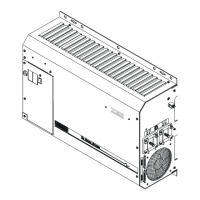OPERATION
Page
90
Copyright Trace Engineering Company, Inc.
5916 - 195th Street N.E.
Arlington, WA 98223
Telephone: 360/435-8826
Fax: 360/435-2229
www.traceengineering.com
PS Series Inverter/Charger
Part No. 3597
Rev. D: November 23, 1999
• SET END CHARGE TIME menu item under the GRID USAGE TIMER (18) menu heading is set to
the time that the inverter disconnects from grid and begins to run the loads from the battery. At this
time, the battery charger will stop charging. If the battery voltage falls to the LOW BATTERY CUT
OUT VDC menu item setting during the inverter operating time period, the AC loads will be
reconnected to the utility grid. This prevents over-discharging the battery. The battery will be charged
when the next START CHARGE TIME is reached.
• Set the START BULK TIME menu item under the BULK CHARGE TRIGGER TIMER (15) menu
heading to a time after the START CHARGE TIME menu item setting. This allows delaying of the
bulk charge cycle to a later time. Before the bulk charge is started, the battery will be charged only to
the float voltage level. The START BULK TIME is usually set to occur during the lowest cost rate
period. Adjusting the SET FLOAT VOLTS DC menu item to just above the normal at rest voltage
(12.6 VDC) will reduce the amount of charging that occurs in the between time periods, yet will allow
limited charging to prevent sulfation of the battery while being partially discharged.
The system should be designed so that the battery is able to operate the loads for the entire peak rate
period without reaching the LOW BATTERY CUT OUT voltage. This may require that heavy loads be
operated only during the non-peak rate period.
This mode may be advantageous when a utility offers time-of-day metering that allows you to buy power
at a variable rate during different time periods. For example, the rate may only $0.04 per kilowatt from
midnight to 6 AM, but $0.16 during the peak period from noon to 6 PM. The in-between period might cost
$0.08 per kilowatt. The idea is to not use power during the peak period and to charge the batteries at
night. A solar array is not required, but since it produces the most power during the peak period, it will
reduce the amount of power required from the battery.
To program the inverter for this example, adjust the START CHARGE TIME menu item to 6 PM (18:00
hours) and the SET END CHARGE TIME menu item to NOON (12:00 hours). The SET START BULK
TIME menu item under the BULK CHARGE TRIGGER TIMER (18) menu heading would be set for after
midnight (00:30) to delay most of the recharging until the cheapest period. Adjusting the SET FLOAT
VOLTS DC menu item setting to the nominal full battery voltage level (12.6 VDC) will reduce the amount
of charging that occurs in the between time periods, yet will allow limited charging to prevent sulfation of
the battery while setting partially discharged.
If the battery is full and power is available from the solar array, it will be used to directly power the AC
loads connected to the inverter output although the utility grid is also connected to the loads. If the
amount of power exceeds the AC loads connected, the battery voltage will increase. An external solar
array controller is required to limit the battery voltage to a safe level and to prevent overcharging and
possible damage to the battery when only light AC loads are being powered.
Note: The round-trip net energy efficiency of charging and discharging a Deep Cycle battery rarely
exceeds 50%. In order for this technique to be cost effective, the off-peak rate for electricity should be at
least half of the on-peak rate. The cost of battery replacement should also be calculated and included
when evaluating this technique.
PEAK LOAD SHAVING MODE
IN BRIEF
Another way the inverter can be used as an energy management tool is to limit the maximum draw the
AC loads place on the utility grid. Many utilities impose a surcharge on their customers based on the peak
load used by a facility. The PS Series Inverter/Charger can be configured to provide all of the power
above a specified level, eliminating the surcharges. With the SWRC, simply adjust the SET GRID (AC1)
AMPS AC menu item to the maximum value allowed by the utility without the peak load surcharge. All AC
loads must be connected to the output of the inverter through the 50-amp AC transfer relay located
internally. Multiple inverters may be required for larger applications with individual groups of loads
connected to each inverter. This can be used in addition to time of day metering and still allows the
inverter to provide a utility back-up function in addition.

